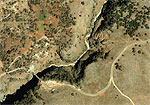 |
From
the almost uninhabited village Aradena
the impressive gorge of Aradena leads the 4,5 km to the sea. It does not
seem long, but still you should calculate at least a couple of hours for
the trip – and maybe even longer in order to enjoy the magnificent
scenery. |

|
|
|
|
|
|
|
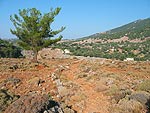 |
Before
reaching the bridge over the gap – and a little before the road leading
to Livaniana – you see a dirth path on your right that leads to a
kalderimi that zigzags down the canyon. Here in the altitude of almost 600
meters there is an excellent view to the village of Aradena
with the old (14-15. century) church of the Archangel Michael. |

|
|
|
|
|
|
|
| You can
also choose to descend into the canyon from the other side, where a
similarly winding path leads down to the bottom. |

|
|
|
|
|
|
|
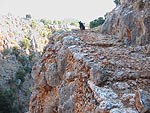 |
After
having forced the kalderimi that winds along the eastern side of the
canyon and having greeted a large
number of goats, you reach the bottom, 87 m below the starting point. |
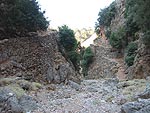
|
|
|
|
|
|
|
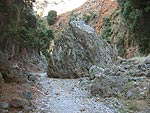 |
The
distance to the bridge seems almost horizontal, but as a matter of fact
there is a difference of 50 meters. |
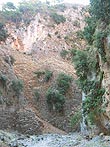
|
|
|
|
|
|
|
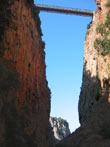 |
138
m above your head you see the 84 m long Aradena
bridge – a so-called Bailey bridge, which originally is a military
bridge strong enough to let tanks and other military vehicles pass. The
bridge at Aradena is actually the world's highest placed Bailey bridge. |
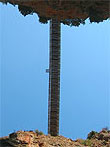
|
|
|
|
|
|
|
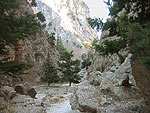 |
After
having passed through a relatively open part – and making sure that you
do not get a bungy jumper in the head, because there is bungee jumping
from the bridge in weekends during summer – you reach some stone stairs
on your right. |
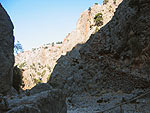
|
|
|
|
|
|
|
| There
are signs that urge you to follow those. Even if the path is poor and you
have to look carefully where you put your feet, you should stop and enjoy
the magnificent spectacle. |
|
|
|
|
|
|
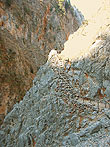 |
|
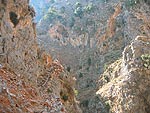
|
|
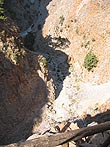
|
|
|
|
|
|
|
| On the
other side of the stairs you can easily understand why you were encouraged
to follow the stone stairs. The alternative would have been to climb down
two latters, which are affixed to some 10 m massive rocks that block the
canyon. |
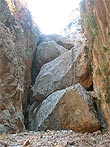
|
|
|
|
|
|
|
|
The
trip continues through areas more or less passable, |
|
|
|
|
|
|
|
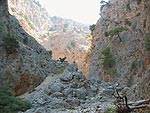 |
|
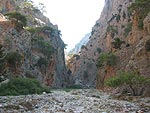
|
|
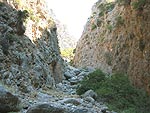
|
|
|
|
|
|
|
| until you
reach a few signs that show the way to respectively Livaniana and Marmara.
Follow the direction towards Marmara. |
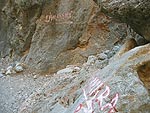
|
|
|
|
|
|
|
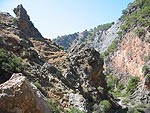 |
Shortly
afterwards is another sign showing the way to the village of Agios Ioannis,
but also here you should follow the direction to Marmara. |
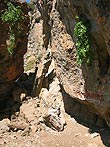
|
|
|
|
|
|
|
 |
From
this point the canyon gets wider, but at some places with a very dense
vegetation, which makes the walk
difficult. Not because of the bushes, but because there are some places
too steep to pass, and it is hard to locate them in the bushes. |
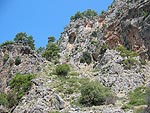
|
|
|
|
|
|
|
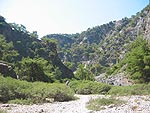 |
|
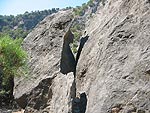
|
|

|
|
|
|
|
|
|
 |
|
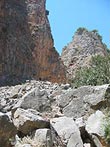
|
|
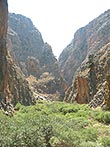
|
|
|
|
|
|
|
|
After a
steep descent with quite a lot of loose stones you get down in the last
part of the gorge, |
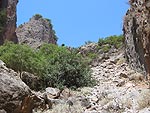
|
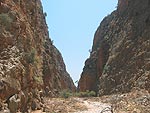 |
where
the path is entirely plane. |
|
|
Shortly
afterward you get a glimpse of the sea, |
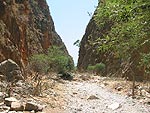
|
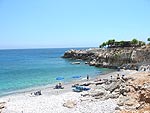 |
and
suddenly you find yourself at the small beach of Dialeskari, |
|
|
|
|
|
| also
known as Marmara because of the marble, especially visible in the eastern
side of the beach. |
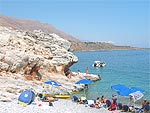
|
|
|
|
|
|
|
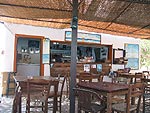 |
Above
the beach is located a small tavern, where you can relax before the last
part
of the trip to Lykos, Foinikas or Loutro. |
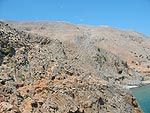
|
|
|
|
|
|
|
|
|
|
|
|
|
|
|
|
|
|
|
|
|














